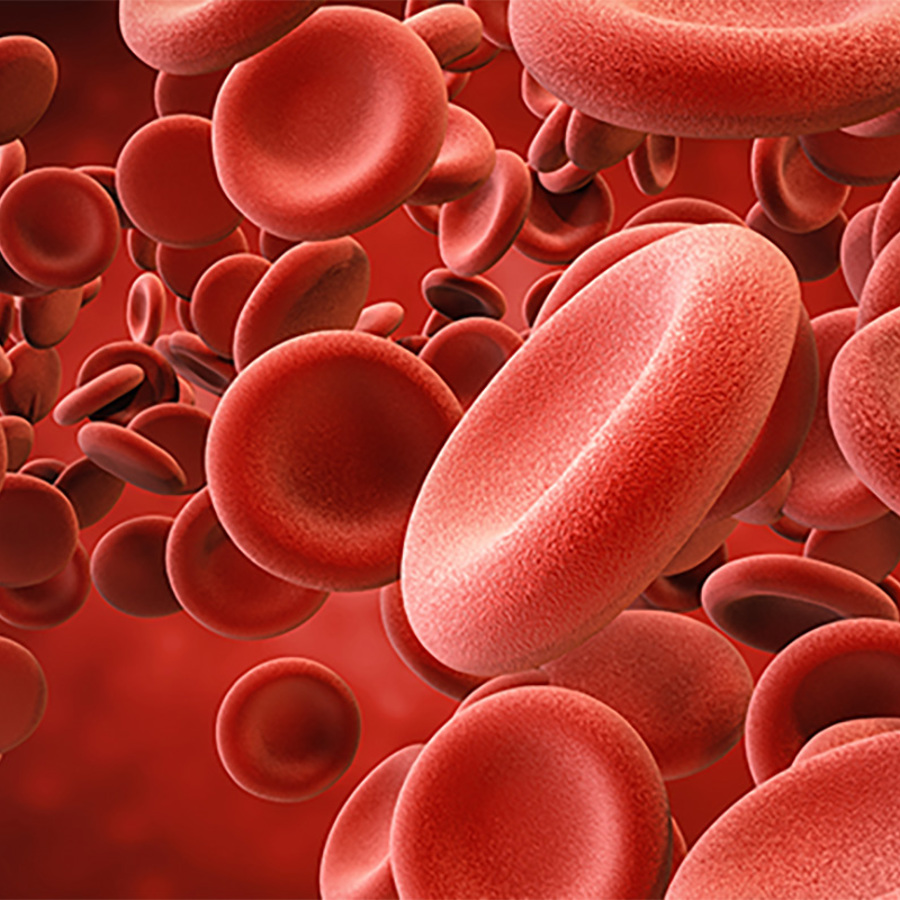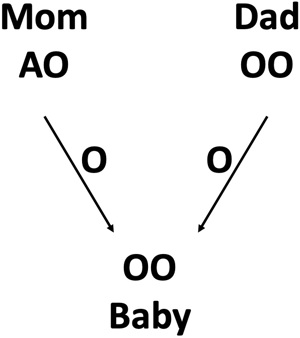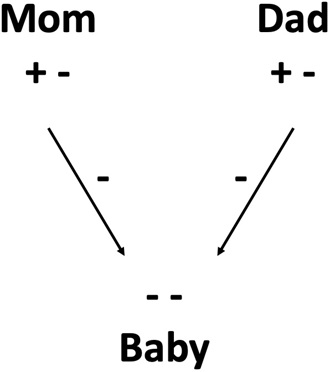
Can a Type O+ parent and a Type A+ parent have an O- child?
July 24, 2013

- Related Topics:
- Blood type,
- ABO blood type,
- Rh factor,
- Common questions,
- Carrier,
- Dominant and recessive,
- Punnett squares
A curious adult Australia asks:
“Could you please explain if it is possible for a father who has O positive blood and a mother with A positive blood to have a baby with O negative blood? I am a little confused and have been trying to research the answer. I would appreciate if you are able to assist.”
Yes this is definitely possible. In this case, the most likely explanation is that dad is a carrier for being Rh- and mom is a carrier for blood type O.
What happened was that dad and mom each passed both an O and an Rh negative to the baby. The end result is an O negative child. Each of their kids has around a 1 in 8 chance of having O negative blood.
This is possible because both O and Rh- are something called recessive traits. This means they can hide out in your DNA without you even knowing it. Until you have a baby with that trait that is…
As you can probably tell, there is a lot going on here for something as seemingly simple as a blood type. In the next couple of sections, I’ll explain what is going on and why each of their kids had a 1 in 8 chance for having an O- child.
As you can probably tell, there is a lot going on here for something as seemingly simple as a blood type. In the next couple of sections, I’ll explain what is going on and why each of their kids had a 1 in 8 chance for having an O- child.
Two Genes, One Blood Type
There is a separate gene for each part of the blood type we are discussing here. The ABO gene is in charge of the A and O (and B and AB) parts of blood type and the RHD gene is responsible for the positive and negative parts.
To explain what happened in your situation, we need to take a step back and think about our genes. In fact, we need to focus on four things:
- We have two copies of most of our genes
- We pass one of our two copies (chosen at random) down to our child
- Genes can come in different versions (or alleles)
- Some gene versions can overpower others
The next step is seeing how these apply to the ABO and RHD genes. At the end, you’ll see how the baby ended up O- with an A+ mom and an O+ dad.
ABO Gene
The ABO gene comes in three different versions, A, B, and O. Keeping in mind that we have two copies of the ABO gene, this means there are six different genetic combinations. They are:
| Genes |
| AA |
| AO |
| AB |
| BO |
| BB |
| OO |
As I said, some gene versions can overpower other ones. In genetics-speak, these alleles are dominant over the recessive alleles.
In the case of the ABO gene, A and B are dominant over O. Here is what that means for blood type:
| Genes | Blood Type |
| AA | A |
| AO | A |
| AB | AB |
| BO | B |
| BB | B |
| OO | O |
Note that A and B are codominant. Neither wins out over the other, which is where AB blood comes from.
Now imagine we have this situation:

We have a mom who has an A and an O version of the ABO gene. She has A blood type but is a carrier for O. This is why in the picture she is AO.
We also have an O dad. People with an O blood type have two copies of the O version of the gene (though there are rare exceptions to this rule). I have shown him as OO.
Dad will always pass an O to his kids (that is all he has to give!) and mom will pass an A half the time and an O the other half of the time. The baby got an O from dad and an O from mom. The baby has O blood type.
Now we are ready to deal with the negative part of the blood type. Luckily this is much simpler.
RHD Gene
This gene comes in two forms, “positive” and “negative”. The positive version is dominant over negative. This means that these are the possible genes and their blood types:
| Genes | Blood Type |
| +/+ | positive |
| +/- | positive |
| -/- | negative |
Now imagine two positive parents who both have one positive version of the RHD gene and one negative version. They both have a positive blood type but carry a hidden negative version of the gene.
As you can see below, if they each happen to pass a negative, the child will end up with two negative copies of the gene. The baby will have a negative blood type.

Odds for O- Blood Type
Next I’ll show you how to figure out that 1 in 8 number for an O- baby. There are a couple of ways to do it.
One “easy” way to figure out the odds of having an O- baby in this case involves just multiplying the chances for each part of the blood type. This is easier than I am making it sound…
Let’s focus first on the O part of the blood type. There is a 100% chance that dad will pass an O to his kids. Again, this is all he has to give. Mom on the other hand has a 50% chance of passing an A and a 50% chance of passing an O.
To figure out how likely the baby is to have an O blood type, we need to multiply these chances together. The first step in doing this is converting percents to decimals. This means that dad is 1.0 and mom is 0.5. When we multiply these together, we get 0.5 or 50%. So the baby has a 50% chance to have an O blood type.
We can do the same thing with the Rh part of the blood type. Each parent has a 50% chance of passing a negative version of the gene down to their child. When we multiply 0.5 by 0.5, we end up with 0.25. So each child has a 25% chance for having a negative blood type.
To figure out how likely an O- blood type is, we need to multiply the chances for an O by the chances for a negative. When we multiply 0.5 by 0.25 we get 0.125. So each child has 12.5% or a 1 in 8 chance of having O- blood.
This kind of explanation isn’t visual enough for some people. They might like a Punnett square better.
A Punnett square is really just a chart that helps us organize the genes. We'll put the mom's ABO versions (alleles) across the top, and the dad's down the side:
| A | O | |
| O | ||
| O |
Each box in the chart represents a possible combination of the alleles donated by each parent (each box gets one entry from mom, one entry from dad). We can say what percent chance a child has of having a particular blood type by how many times that blood type shows up in the chart (one out of four is 25%, two out of four is 50%, etc.).
If we fill in the possible mixtures of alleles each kid could get in our example, we get a chart that looks like this:
| A | O | |
| O | AO | OO |
| O | AO | OO |
As you can see there is a 50% chance for AO and a 50% chance for OO. For blood type, that means a 50% chance for A and a 50% chance for O.
You can do the same with the Rh factor gene. Remember both mom and dad are Rh-positive and each has one positive and one negative version of the RHD gene. So we make a Punnett square the same way by putting mom’s alleles along the top and dad’s along the side like this:
| + | - | |
| + | +/+ | +/- |
| - | +/- | -/- |
As you can see, there is a 1 in 4 chance for +/+, a 1 in 2 chance for +/- and a 1in 4 chance for -/-. In terms of blood type this translates to a 75% chance for having a positive blood type and a 25% chance for a negative one.
Now let’s put it all together. This might be where you wish you weren’t a visual learner!
| A+ | O+ | A- | O- | |
| O+ |
AO |
OO |
AO |
OO |
| O- |
AO |
OO |
AO |
OO |
| O+ |
AO |
OO |
AO |
OO |
| O- |
AO |
OO |
AO |
OO |
To simplify things, we can get rid of any duplicate alleles. As you can see, dad has two O+ and two O- alleles. When we get rid of the extra one, we have this, easier to manage table:
| A+ | O+ | A- | O- | |
| O+ |
AO |
OO |
AO |
OO |
| O- |
AO |
OO |
AO |
OO |
As you can see, only one out of the eight boxes is OO -/-. That means each child of these parents has a 1 in 8 chance to have a baby with an O- blood type. Each of their kids will also have a 3 in 8 chance of having A+, a 3 in 8 chance of being O+, and a 1 in 8 chance for being A-.

Author: Dr. D. Barry Starr
Barry served as The Tech Geneticist from 2002-2018. He founded Ask-a-Geneticist, answered thousands of questions submitted by people from all around the world, and oversaw and edited all articles published during his tenure. AAG is part of the Stanford at The Tech program, which brings Stanford scientists to The Tech to answer questions for this site, as well as to run science activities with visitors at The Tech Interactive in downtown San Jose.
 Skip Navigation
Skip Navigation
